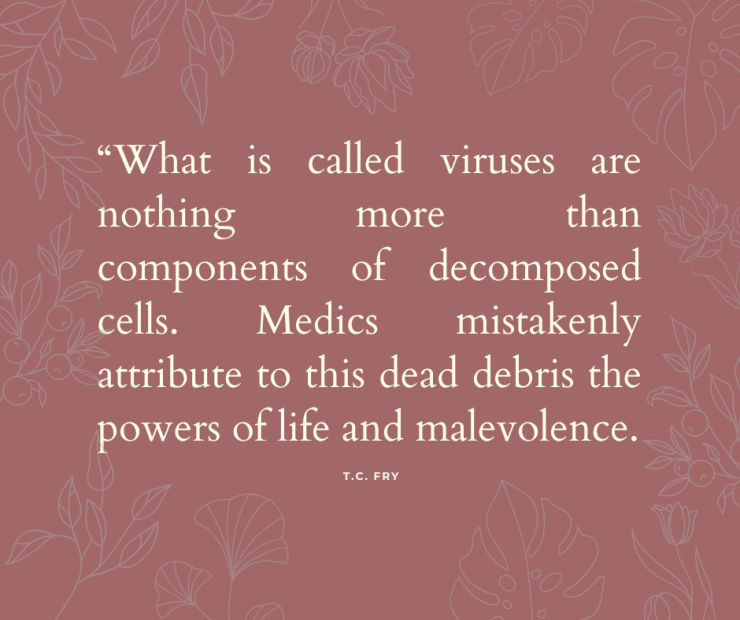If Germs Don’t Kill, What About Septicemia?
People often ask: “If germs don’t cause disease, then what about septicemia (sepsis, going septic, septic shock)?”
From a Natural Hygiene perspective, septicemia is not some rogue bacterial invasion that mysteriously overpowers the body. It is the body’s own healing effort that has been complicated, obstructed, and driven into a life-threatening stage, almost always by well-meaning but harmful interventions.
A wound becomes septic when its natural drainage and cleansing process is interfered with. The body wants to drain toxic waste, dead cells, and debris out through the wound. This discharge is part of the eliminative process, Nature’s way of cleansing the injured area and preventing internal poisoning. When that natural outlet is blocked, the waste is forced to remain inside, reabsorbing into the bloodstream and overwhelming the system.
How this happens in practice:
- Bandaging wounds – Wounds require airflow and the ability to drain; placing a bandage on the wound impairs the elimination of waste products, reduces airflow, and, if the bandage is too tight, blood flow and lymph flow are also impaired. Blood flow brings repair materials, the lymphatic system eliminates waste products, and constricting the flow of either results in impaired healing.
- Closing the wound with stitches – Stitches force close a wound, impairing the elimination of the waste the body requires to drain. While there are times of serious major injury that might require stitching, care must be taken to allow proper drainage. If drainage is not allowed, septicemia may be induced by the trapping of waste internally.
- Packing or covering the wound with antiseptic chemicals, antibiotics, salves, herbs or ointments that damage healthy cells and impair the body’s healing. Bacteria are put in place by the body, for the benefit of the body, at the site of all injuries. These bacteria are part of the cleaning and repair process. By applying antibacterial substances, we kill the body’s own repair team, impairing healing, and because these substances are injurious to the body, the body is forced to rapidly close the wound. Wounds are meant to close slowly so they can drain properly and eliminate poisons. If they are forced to close rapidly due to more poisons being applied externally, then the cellular waste which is a result of the wound becomes a poison trapped internally.
When we intervene in the healing processes with bandages, stitches, ointments ,or other salves, the toxic material, which includes the body’s own waste, cell debris, and by-products of bacterial breakdown, accumulates faster than the body can remove it. This is classic toxemia, the true cause of all disease.
As Shelton explains, bacteria do not initiate disease; they arrive after the fact, when waste material is present, and assist in breaking it down for elimination. Bacteria are a symptom of disease and tissue injury, not a cause. In septicemia, these symbiotic bacteria are present in large numbers because there is an abundance of cellular waste, toxins, or debris for them to work on. But the danger does not come from the bacteria themselves; it comes from the toxic condition of the internal environment caused by the interference in normal healing processes.
Fasting: the emergency measure
If someone reaches a true septic state, complete physiological rest (fasting) offers the best chance for recovery. Fasting frees up nerve energy, stops the intake of new toxins, and allows the body to concentrate all available resources on neutralizing poisons, breaking down dead tissue, and restoring balance. But more important than knowing how to recover from septicemia is knowing how to avoid it entirely.
Prevention according to Natural Hygiene:
- Allow wounds to remain open to the air when possible so they can drain naturally. If a wound must be covered to protect it for a time, keep the bandage loose to allow airflow and remove the bandage frequently to avoid excess moisture building around the wound, injuring the tissues surrounding the wound.
- Support the body’s eliminative effort instead of suppressing it with drugs or antiseptics. Fast, or eat only very lightly, of foods natural to the human diet – fruits, salads, nuts, and seeds – until the healing has been completed.
- If the wound must be cleaned of debris, use only pure water, never chemical disinfectants that injure cells and impede healing.
- Rest the body and avoid overfeeding, especially on protein-heavy or processed foods that create more toxic waste. Avoiding animal proteins and secretions is most important, as these are the heaviest burdens of an unnatural diet.
When the body’s needs are met, fresh air, pure water, adequate rest, wholesome food, it is fully capable of cleansing itself without complication. Septicemia, like all advanced disease conditions, is not caused by the germ but by the accumulation of poisons (cellular debris, waste, drugs, herbs, etc.) and the obstruction of the body’s natural avenues of elimination. Remove the obstruction, stop adding to the toxic load, and the body will finish the healing work it started.
As Dr. Shelton wrote:
“Disease is a remedial effort, a struggle of the vital powers to purify the system and recover the normal state. This effort should be aided… but never suppressed.”
In the case of septicemia, the tragedy is that it almost always results from preventable suppression/intervention, turning the body’s cleansing process into a closed trap. The real cure lies not in killing bacteria, but in restoring the free, unobstructed flow of Nature’s healing work.
















































